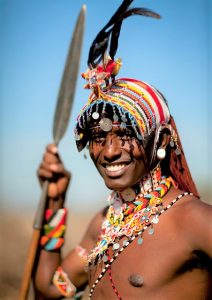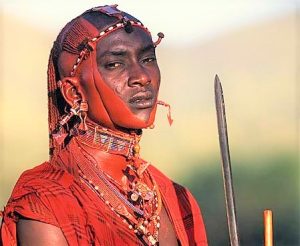[gravityform id=”1″ title=”false” description=”false” ajax=”true”]
Mashariki Television Networks Limited Email: info@themasharikinewspaper.com
Email Us
Our address
Mashariki Communications Centre
Meru-Maua Road
Main Telephone: +254 797 372 837
Postal Address: P. O. Box 747-60200, Meru, KenyaWe are social

A Samburu Warrior | PHOTO-Courtesy
By Sponyoo and Kuura Ibeere
In this edition, we briefly focus on two communities that look similar yet distinct in a number of ways. The Samburu and the Maasai reside in most parts of the Samburu and Laikipia counties respectively.
However, at the end of the day, the communities are cousins who share many cultural values and traditions.
The Samburu and Maasai are both pastoral communities that migrated to Kenya and Tanzania from Sudan. They settled in the Rift Valley region, with the Maasai settling in the southern part and the Samburu in the northern part. The Samburu migrated to their current location around the 16th century, while the Maasai arrived later in the 19th century.
The two communities have different migration histories. The Maasai were known for their warrior prowess, which helped them conquer and control vast territories in Kenya and Tanzania. The Samburu, on the other hand, were more peaceful and settled in smaller communities. They were also more accepting of other tribes and traded with them.
The Samburu and Maasai speak different languages. The Maasai language is Maa, while the Samburu language is Samburu. While the two languages are closely related, they have different dialects and vocabulary.
The Samburu and Maasai have different dressing styles and ornaments. The Maasai are known for their colorful clothing, which is adorned with beads and other ornaments. The Samburu, on the other hand, wear dark clothing and have elaborate hairstyles.
The Samburu and Maasai have different types of shelters. The Maasai live in semi-permanent houses made of mud and cow dung, while the Samburu live in temporary huts made of sticks, grass, and cow dung.

A Maasai Warrior | PHOTO-Courtesy
The Maasai and Samburu have different dietary habits. The Maasai are known for their love of meat, milk, and blood, while the Samburu have a more varied diet that includes vegetables, grains, and fruits.
The Samburu and Maasai have different social organizations. The Maasai are organized into clans, each with its own leader, while the Samburu have a more democratic social structure.
The Samburu and Maasai have different livelihoods. The Maasai are known for their livestock, while the Samburu practice a mix of livestock rearing, farming, and trading.
The Maasai and Samburu have different livestock management practices. The Maasai keep mainly cattle, while the Samburu keep cattle, sheep, and goats.
The Samburu and Maasai have different economic activities. The Maasai are known for their beadwork and selling of livestock, while the Samburu concentrate on various economic activities that include trade and agriculture
The Maasai and Samburu have different political organizations. The Maasai have a hierarchical system with a centralized authority led by a council of elders, while the Samburu have a more decentralized system with leadership at the village level.
The Maasai and Samburu have different leadership structures. The Maasai are led by a group of elders, while the Samburu have both male and female leaders who are elected by the community.
The Samburu and Maasai have different access to education. The Maasai have a higher rate of illiteracy and a lower enrollment rate in schools compared to the Samburu.
The Samburu and Maasai have different access to healthcare services. The Samburu have better access to healthcare services compared to the Maasai.
Despite the differences between the two communities, the Samburu and Maasai share some similarities. They are both pastoral communities that have a deep respect for their livestock. They both have rich cultural practices and traditions that have survived for centuries. They also share a close relationship with the environment and have a deep understanding of the natural world.
In conclusion, the Samburu and Maasai are two distinct communities with different cultures, languages, traditions, and practices. Their differences and similarities offer a unique glimpse into the diversity of East African ethnic communities.

Comments (0)